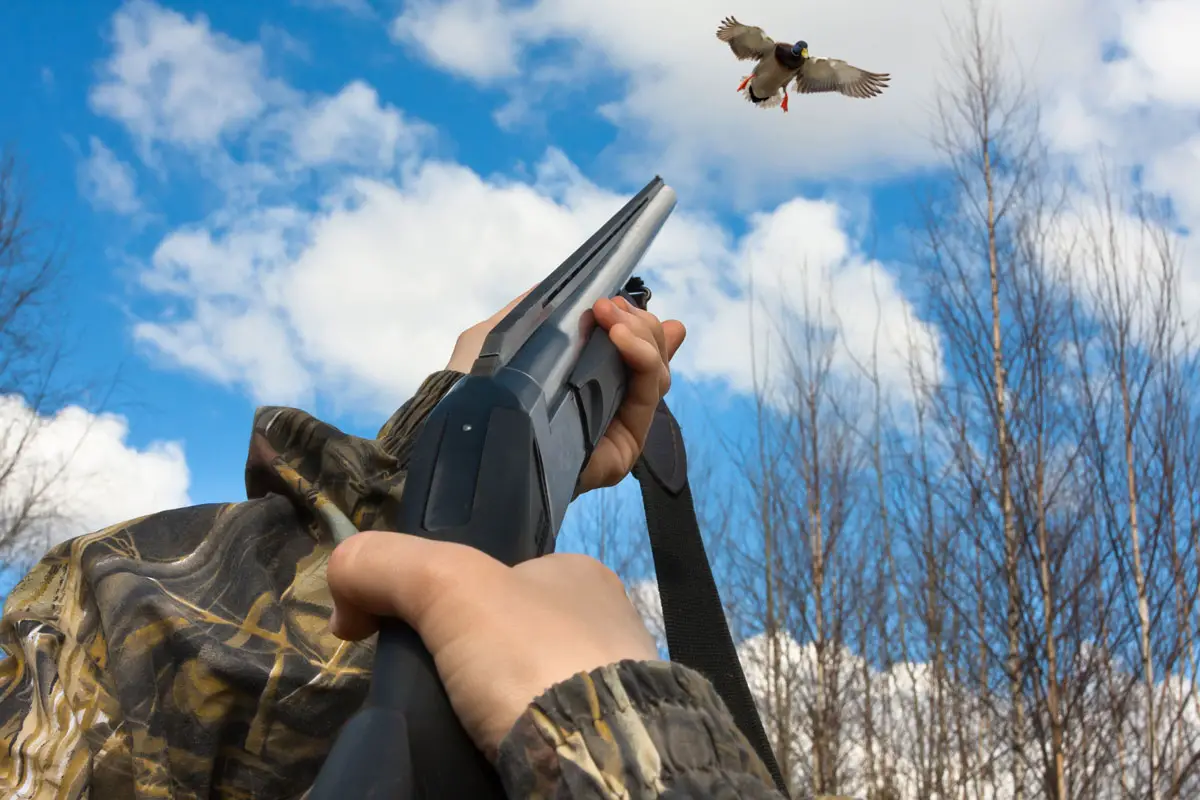The question, “How far does 12 gauge birdshot travel?” is crucial for anyone handling shotguns. The maximum range of 12 gauge birdshot can exceed several hundred yards, even though its effective range for hunting is much shorter. It’s very important to know these distances for safety and responsible shooting. This article will explore the range, lethality, and safety aspects of 12 gauge birdshot.

Image Source: weaponsman.com
Deciphering 12 Gauge Birdshot Range
The range of 12 gauge birdshot isn’t a single, fixed number. It varies based on several factors. These factors affect how far the pellets will travel and how dangerous they can be.
Factors Influencing Birdshot Distance
- Shot Size: Birdshot comes in different sizes, typically numbered from 9 (smallest) to BB (largest). Smaller shot sizes lose velocity faster due to air resistance and have a shorter 12 gauge birdshot range.
- Load Weight: The amount of shot in a shell affects its initial velocity and, consequently, the birdshot travel distance. Heavier loads generally maintain velocity better.
- Elevation Angle: The angle at which the shotgun is fired significantly impacts the birdshot maximum distance. A 45-degree angle typically yields the greatest horizontal distance.
- Environmental Conditions: Wind, air density, and even humidity can influence how far birdshot travels. Strong winds can push the pellets off course and affect their range.
- Choke: The choke of a shotgun barrel constricts the shot pattern, affecting its density and range. A tighter choke will keep the shot pattern tighter for longer, increasing the effective range.
12 Gauge Shot Distance: Maximum vs. Effective
It’s important to distinguish between the maximum range and the effective range of 12 gauge birdshot.
- Maximum Range: This refers to the absolute farthest distance the pellets can travel when fired. This distance is primarily important from a safety perspective. The 12 gauge pellet range can be over 800 yards, or almost half a mile, in ideal conditions.
- Effective Range: This is the distance at which the birdshot still has sufficient energy to reliably and ethically kill a target. For most birdshot used for hunting, the birdshot effective range is between 25 and 40 yards.
| Feature | Maximum Range (Yards) | Effective Range (Yards) |
|---|---|---|
| Distance | 800+ | 25-40 |
| Primary Concern | Safety | Ethical Harvest |
| Energy at Target | Low | Sufficient for Kill |
| Pattern Density | Very Sparse | Dense Enough for Hit |
Fathoming Birdshot Lethality
While birdshot is designed for hunting small game, it’s still a potentially lethal projectile. The 12 gauge birdshot lethality range depends on several factors, including pellet size, distance, and the target’s vulnerability.
How Far Can Birdshot Kill?
At close ranges (within 20 yards), birdshot can cause serious injury or death. As the distance increases, the pellets spread out, and their individual energy decreases. However, even at longer ranges (50+ yards), birdshot can still penetrate skin and cause painful injuries, especially to the eyes or other sensitive areas.
- Close Range (0-20 yards): High risk of serious injury or fatality. Pellets are tightly grouped, delivering significant energy.
- Medium Range (20-40 yards): Risk of serious injury decreases, but penetration is still possible. Pattern begins to spread, reducing the concentration of energy.
- Long Range (40+ yards): Risk of serious injury is lower, but still present. Pellets have lost significant velocity, but can still cause skin penetration and eye injuries.
Factors Affecting Lethality
- Pellet Size: Larger pellets (e.g., #4 birdshot) retain more energy and are more likely to cause serious injury at longer distances compared to smaller pellets (e.g., #8 or #9 birdshot).
- Target Area: A shot to the head or vital organs is obviously more dangerous than a shot to a limb.
- Clothing: Heavy clothing can reduce the penetration of birdshot, but it doesn’t eliminate the risk of injury.
Birdshot Safety Distance: Prioritizing Caution
Due to the long range of birdshot, it’s vital to establish and adhere to strict safety protocols when handling shotguns.
Establishing Safe Zones
- Know Your Target and Beyond: Before pulling the trigger, always be absolutely sure of your target and what lies beyond it. Birdshot can travel a significant distance, so you need to be aware of any potential hazards in the line of fire.
- No Shooting Towards Buildings or Roads: Never fire a shotgun in the direction of buildings, roads, or other areas where people or animals might be present.
- Consider the Environment: Be mindful of the surrounding environment, including terrain and vegetation. Pellets can ricochet off hard surfaces or penetrate dense foliage.
12 Gauge Birdshot Safety Distance Recommendations
While there’s no single “safe” distance, it’s generally recommended to maintain a buffer zone of at least several hundred yards in all directions when shooting birdshot. This is especially important in areas with limited visibility or where other people might be present.
| Scenario | Recommended Buffer Zone (Yards) | Rationale |
|---|---|---|
| Open Field | 300+ | Accounts for maximum potential range and wind drift. |
| Wooded Area | 200+ | Reduced visibility increases the risk; ricochet is possible off trees and hard surfaces. |
| Near Buildings/Roads | Do Not Shoot | The Risk is Too High. |
| Uphill Shooting | 400+ | Gravity will increase the range of the pellets. |
Safe Gun Handling Practices
- Treat Every Firearm as if it is Loaded: Always handle shotguns with the utmost care, even if you believe they are unloaded.
- Keep the Muzzle Pointed in a Safe Direction: Never point the muzzle of a shotgun at anything you don’t intend to shoot.
- Keep Your Finger Off the Trigger Until Ready to Fire: This is a fundamental rule of gun safety.
- Be Sure of Your Target and What is Beyond It: This is the most important safety rule when shooting birdshot.
- Wear Appropriate Safety Gear: Eye and ear protection are essential when shooting shotguns.
Types of 12 Gauge Birdshot
Birdshot is classified by pellet size, with each size designed for specific purposes. The smaller the number, the larger the pellet size.
Common Birdshot Sizes and Uses
- #9 Birdshot: Used for skeet shooting and very small birds at close range.
- #8 Birdshot: A popular choice for quail, dove, and other small game.
- #7 1/2 Birdshot: Similar to #8, but with slightly larger pellets for a bit more range.
- #6 Birdshot: Suitable for slightly larger birds like pigeons and grouse.
- #4 Birdshot: Can be used for pheasant or larger birds at longer ranges.
- BB Birdshot: The largest birdshot size, sometimes used for pest control (check local regulations).
Birdshot vs. Buckshot vs. Slugs
It’s important to differentiate birdshot from other types of shotgun ammunition like buckshot and slugs.
- Birdshot: Contains many small pellets designed to spread out over a wide area, used for hunting birds and small game.
- Buckshot: Contains larger pellets (typically .24″ to .36″ diameter) designed for hunting larger game or for self-defense. Has a much longer effective and dangerous range than birdshot.
- Slugs: A single, solid projectile designed for hunting large game like deer. Slugs have the longest range and the greatest stopping power.
| Ammunition Type | Pellet Size | Typical Use | Range | Lethality |
|---|---|---|---|---|
| Birdshot | Small (#9 to BB) | Birds, small game | Short to Medium | Low to Med |
| Buckshot | Large (e.g., 00) | Deer, self-defense | Medium to Long | High |
| Slugs | Single Projectile | Deer, large game | Long | Very High |
Lawful and Ethical Considerations
Always be aware of and comply with all local, state, and federal laws regarding the use of shotguns and birdshot. Ethical hunting practices dictate that you use appropriate ammunition for the game you’re hunting and that you take only clean, humane shots within the effective range of your ammunition.
Frequently Asked Questions (FAQ)
- What is the maximum range of 12 gauge birdshot? The maximum range can exceed 800 yards, depending on factors like shot size, load, and elevation angle.
- How far can birdshot kill? At close range (under 20 yards), birdshot can be lethal. Beyond that, it can still cause serious injury, especially to sensitive areas like the eyes.
- What is the effective range of 12 gauge birdshot for hunting? The effective range is typically between 25 and 40 yards, depending on the size of the bird and the shot size.
- Is it safe to shoot birdshot in a residential area? It is generally unsafe and illegal to shoot birdshot in a residential area due to the risk of injury and property damage. Always check local laws and regulations.
- Can birdshot penetrate walls? Yes, birdshot can penetrate walls, especially at close range. The penetration depends on the type of wall and the distance.
- What safety precautions should I take when shooting birdshot? Always be sure of your target and what’s beyond it, wear eye and ear protection, and maintain a safe shooting distance from buildings, roads, and other people. Treat every firearm as if it is loaded.
- Does choke affect the range of birdshot? Yes, the choke of a shotgun barrel affects the pattern and effective range of birdshot. A tighter choke will keep the shot pattern tighter for longer, increasing the effective range.
By being informed about the range, lethality, and safety aspects of 12 gauge birdshot, you can handle shotguns responsibly and minimize the risk of accidents. Always prioritize safety and follow ethical hunting practices.

Hi, I’m Candace Wafford, a travel and food blogger based in Lexington, Kentucky. As a corporate traveler, I’ve had the chance to explore a lot of places, but now I’m on a mission to travel full-time. My goal? To figure out how to take my cat along for the adventure! Here at destinationdorworth.com, I share my experiences and tips on outdoor activities, travel, and of course, the best food spots I come across. I hope my blog inspires you to explore more and eat well on your journeys!
